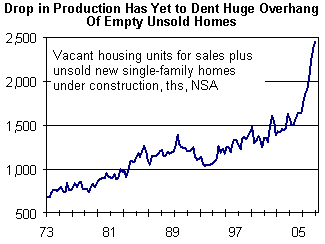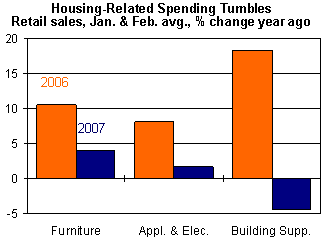|
The Last Bear Standing
This week we look at the growing disconnect between the US economy and the stock markets. One is slowing and the other is exploding to the upside. One of my mentors once said that it is the duty of the markets to prove the most-possible people wrong. So far, I am clearly in the wrong category. We will look at some explanations as to why, ponder if this can continue, and more.
The Last Bear Standing
"An economist is a trained professional paid to guess wrong about the economy. An econometrician is a trained professional paid to use computers to guess wrong about the economy." (Sent to me by friend Kathleen Camilli)
The last few weeks we have seen a series of negative economic data, culminating with Friday's surprisingly low estimate of first-quarter GDP at 1.3%. As we will see, the housing market continues to weaken, prompting calls for the Fed to start easing. But as I have noted since last summer, inflation is going to be a problem. On the same day that we got the poor GDP number, we learned that the Fed's preferred inflation measure, which is tied to consumer spending and strips out food and energy costs, rose at a 2.2% annual rate, up from a 1.8% fourth-quarter gain. Mild stagflation, predicted as the ultimate outcome of radical Fed easing in this column five years ago, is now here. Even if I can't get the stock market right, I did get that one.
So, how does the market react to the bad news? By going higher, naturally. It has now been up 19 of the last 21 trading days. Amazing.
Last week, at my Strategic Investment Conference (co-hosted by Altegris Investments) we concluded the conference as we traditionally do with a panel taking questions from the audience. On the panel was Paul McCulley, Dr. Woody Brock, Richard Russell (of Dow Theory Letter fame), and myself. Of course, someone asked our thoughts about the direction of the stock market.
Richard started off, and I expected him to give his usual bearish answer, but it did not come.
"We are seeing all three Dow averages (30, transports and utilities) at all-time highs. My own proprietary private indicator, the PTI (primary trend index) is bullish. I expect to see all the markets go on to record new highs."
And clearly the market agrees, as the Dow is up over 200 points in the last four days, and the S&P 500 is only 34 points from a new all-time high. Other indexes are either at or near their highs, with the only real exception being the NASDAQ.
Dow 36,000???
I had several people send me a copy of Jeremy Grantham's latest client letter. Long-time readers are familiar with Grantham, as I have quoted from his wisdom more than a few times. Grantham is chairman of Grantham Mayo Van Otterloo, which manages around $150 billion. He is famous for his value orientation and research.
I quoted this bit from Barrons about four years ago:
"My colleague Ben Inker has looked at every bubble for which we have data. His research goes back years and years and includes stocks, bonds, commodities and currencies. We found 28 bubbles. We define a bubble as a 40-year event in which statistics went well beyond the norm, a two-standard-deviation event. Every one of the 28 went back to trend, no exceptions, no new eras, not a single one that we can find in history."
The Street.com excerpted some of the more salient quotes from Grantham's recent newsletter. From their site:
"While euphoria sweeps stock markets here and worldwide, there are at least a few voices of dissent. One, unsurprisingly, is legendary value investor Jeremy Grantham - the man Dick Cheney, plus a lot of other rich people, trusts with his money. Grantham ... has been a voice of caution for years. But he has upped his concerns in his latest letter to shareholders. Grantham says we are now seeing the first worldwide bubble in history covering all asset classes.
"'Everything is in bubble territory,' he says. 'Everything. The bursting of this bubble will be across all countries and all assets.'
"'From Indian antiquities to modern Chinese art,' he wrote in a letter to clients this week following a six-week world tour, 'from land in Panama to Mayfair; from forestry, infrastructure and the junkiest bonds to mundane blue chips; it's bubble time!'
"'Everyone, everywhere is reinforcing one another,' he wrote. 'Wherever you travel you will hear it confirmed that 'they don't make any more land,' and that 'with these growth rates and low interest rates, equity markets must keep rising,' and 'private equity will continue to drive the markets.'
"As Grantham points out, a bubble needs two things: excellent fundamentals and easy money. 'The mechanism is surprisingly simple,' he wrote. 'Perfect conditions create very strong 'animal spirits,' reflected statistically in a low risk premium. Widely available cheap credit offers investors the opportunity to act on their optimism.'
"And it becomes self-sustaining. 'The more leverage you take, the better you do; the better you do, the more leverage you take. A critical part of a bubble is the reinforcement you get for your very optimistic view from those around you.'"
An Exponential Phase of the Bubble
So, does he counsel you to run for the hills? No. Their study of bubbles suggests there is a short but dramatic "exponential" phase before the bubble bursts. He writes:
"My colleagues suggest that this global bubble has not yet had this phase and perhaps they are right. ... In which case, pessimists or conservatives will take considerably more pain."
So what is fueling the stock market if it is not a rising economy? Let's look at a few possible reasons.
First, we are seeing large amounts of stock being taken out of public hands and going into private hands. Lombard Street Research reports that net retirement of stock in nonfinancial US companies reached 5.2% of GDP in the last quarter of 2006, and about 6.5% of their market value. About 85% of that was financed by debt of some kind, either through buy-backs, takeovers, or private equity (the latter of which is highly leveraged).
Second, money supply does matter. We are seeing the broad money supply indicators (M-2 and M-3) rise not only in the US but all over the world. This is not a central bank pumping function but a market-driven phenomenon, as leverage is increasing the capital deployed in today's markets. The central banks of the world have largely lost the ability to control the money supply, other than by the narrowest of measures, which are increasingly less meaningful. We are not seeing the rapid increase in money supply show up in inflation or loss of buying power but rather as inflation in asset prices of every kind, as Grantham notes.
Finally, rising prices create their own kind of self-fulfilling momentum. As more and more people throw caution to the wind and jump into the market, hoping to capture some of the profits they see their friends making so effortlessly, you finally get down to the last bear standing. Mr. Market will do whatever it takes to prove the most people wrong. And one of his favorite things to do is to create momentum markets which defy the logic of the underlying fundamentals. It then ends in tears.
Housing Numbers Continue to Deteriorate
As I have written since last fall, I still expect to see a slowdown or recession in the US this year as a result of the housing market slowdown. There is nothing in the data that came out this week to change that view. I think the probability of a recession is now over 50%.
Total home sales are at their lowest level in almost four years. New home sales are close to a seven-year low. Prices are falling in many areas where there was a bubble in prices. Even though we have seen a significant decline in new home construction, the number of homes for sale continues to rise. Look at this chart from www.dismal.com.

The homeowner vacancy rate rose to a new all-time high, even as rental vacancy rates fell slightly. Overall home ownership in the US is falling and is now at a three-year low. Including new homes under construction, there are a total of 2.5 million homes vacant, which is well over 3% of the total of the US housing stock (77.2 million non-rental homes).
A weakening housing market has four major effects on spending, according to Scott Hoyt, writing for the Dismal Scientist. First, it obviously hurts spending on housing construction-related spending, such as home improvements, furniture and appliances, and building materials.

Second is through the job market. Housing-related employment was up to 50,000 jobs a month during the boom and is now a drag on employment. Hoyt suggests the worst is still to come, as many smaller employers have not yet cut back.
Third, there is a clear drag on household wealth, where there is an estimated 9 cents of consumer spending for each dollar in the increase in the value of a home. With the likely prospect that home values are going to fall, this will put consumers in a less spirited mood.
And finally, the boost from mortgage equity withdrawal (MEW) is reversing. The largest part of MEW came from the realization of capital gains as homes were sold. "The only source of MEW that remains strong is cash-out refinancing," Hoyt notes.
"It should be pointed out that spending from the wealth effect and MEW impact spending with a lag. The wealth effect is understood to play out over about two years. Spending from MEW occurs more quickly, but can still take up to three quarters."
This is starting to impact consumer spending this quarter and will have more of an effect in the latter half of the year. That being said, consumer spending has held up surprisingly well, given the high gas prices. Can it continue? I think there are some serious headwinds. Consumer sentiment again dropped this last month. Target warns of weak April sales, and higher gas prices suggest that this quarter could see an even weaker economy than last quarter. A GDP number of less than1% for the second quarter is a real possibility.
Corporate earnings are slowing down, and if you take out energy companies (big oil), corporate earnings are going to be advancing at their slowest pace since the last recession, well below the double digits the market has become used to. The positive earnings reports we have been getting stem largely from the fact that initial expectations were so low and it was much easier to hit a lowered target.
Couple all that with the fact that taxes are likely to rise, as the Democrats are not going to extend the Bush tax cuts; and all in all, it is a strange environment for a rising stock market.
So, I admit it. I simply do not understand the disconnect between the underlying weakening fundamentals of the economy and the rising stock market. Maybe it is different this time. But I am not wanting to play that sucker's game.
John Mauldin is president of Millennium Wave Advisors, LLC, a registered investment advisor. Contact John at John@FrontlineThoughts.com.
Disclaimer
John Mauldin is president of Millennium Wave Advisors, LLC, a registered investment advisor. All material presented herein is believed to be reliable but we cannot attest to its accuracy. Investment recommendations may change and readers are urged to check with their investment counselors before making any investment decisions.
|